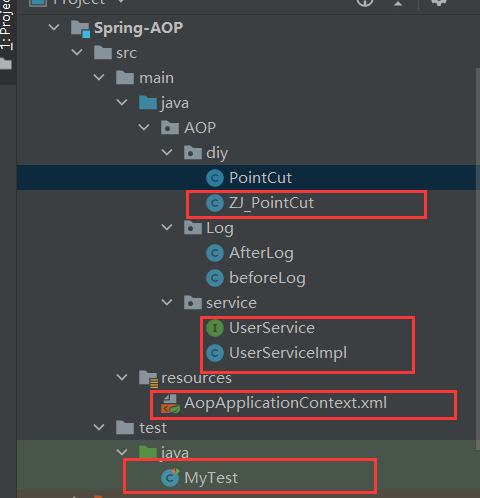学习Spring-AOP时,实现例子有三种方法,我都会放到下面:
第一种运用Spring中原生 的API实现用到的文件夹有:

第二种自定义类实现用到的文件夹有:

第三种:注解方法实现用到的有:


1 package AOP.diy; 2 3 public class PointCut { 4 public void before1(){ 5 System.out.println("******被执行前******"); 6 } 7 public void after1(){ 8 System.out.println("******被执行后******"); 9 } 10 }

1 package AOP.diy; 2 3 4 import org.aspectj.lang.annotation.Aspect; 5 import org.aspectj.lang.annotation.Before; 6 import org.springframework.stereotype.Component; 7 8 @Component 9 @Aspect 10 public class ZJ_PointCut { 11 12 13 @Before("execution(* AOP.service.UserServiceImpl.*(..))") 14 public void before(){ 15 System.out.println("执行前——————"); 16 } 17 }

1 package AOP.Log; 2 3 import org.springframework.aop.AfterReturningAdvice; 4 5 import java.lang.reflect.Method; 6 7 public class AfterLog implements AfterReturningAdvice{ 8 public void afterReturning(Object result, Method method, Object[] objects, Object o1) throws Throwable { 9 System.out.println("执行了" + method.getName() +"返回了" + result); 10 } 11 }

1 package AOP.Log; 2 3 import org.springframework.aop.MethodBeforeAdvice; 4 5 import java.lang.reflect.Method; 6 7 public class beforeLog implements MethodBeforeAdvice { 8 9 10 public void before(Method method, Object[] objects, Object o) throws Throwable { 11 System.out.println(o.getClass().getName() + "的" + method.getName() +"被执行了"); 12 } 13 }

1 package AOP.service; 2 3 public interface UserService { 4 public void add(); 5 public void delete(); 6 public void select(); 7 public void update(); 8 9 }

1 package AOP.service; 2 3 public class UserServiceImpl implements UserService{ 4 public void add() { 5 System.out.println("增加了一个用户"); 6 } 7 8 public void delete() { 9 System.out.println("删除了一个用户"); 10 } 11 12 public void select() { 13 System.out.println("查询了一个用户"); 14 } 15 16 public void update() { 17 System.out.println("修改了一个用户"); 18 } 19 }

1 <?xml version="1.0" encoding="UTF-8"?> 2 <beans xmlns="http://www.springframework.org/schema/beans" 3 xmlns:xsi="http://www.w3.org/2001/XMLSchema-instance" 4 xmlns:aop="http://www.springframework.org/schema/aop" 5 xsi:schemaLocation="http://www.springframework.org/schema/beans 6 https://www.springframework.org/schema/beans/spring-beans.xsd 7 http://www.springframework.org/schema/aop 8 https://www.springframework.org/schema/aop/spring-aop.xsd"> 9 10 <bean id="userService" class="AOP.service.UserServiceImpl"/> 11 <bean id="beforelog" class="AOP.Log.beforeLog"/> 12 <bean id="afterlog" class="AOP.Log.AfterLog"/> 13 14 <!-- 方法一:Spring的原生API接口--> 15 <!-- 配置aop--> 16 <!-- <aop:config>--> 17 <!--<!– expression:表达式,exection(要执行的位置)–>--> 18 <!-- <aop:pointcut id="pointcut" expression="execution(* AOP.service.UserServiceImpl.*(..))"/>--> 19 20 <!-- <aop:advisor advice-ref="afterlog" pointcut-ref="pointcut"/>--> 21 <!-- <aop:advisor advice-ref="beforelog" pointcut-ref="pointcut"/>--> 22 <!-- </aop:config>--> 23 24 25 <!--<!– 方法二:自定义类–>--> 26 <bean id="diy" class="AOP.diy.PointCut"/> 27 <aop:config> 28 <aop:aspect ref="diy"> 29 <!-- 切入点--> 30 <aop:pointcut id="point" expression="execution(* AOP.service.UserServiceImpl.*(..))"/> 31 32 <!-- 通知--> 33 34 <aop:before method="before1" pointcut-ref="point"/> 35 <aop:after method="after1" pointcut-ref="point"/> 36 </aop:aspect> 37 </aop:config> 38 39 <!--方法三:注解实现--> 40 <!--<bean id="zj_point" class="AOP.diy.ZJ_PointCut"/>--> 41 <!-- <aop:aspectj-autoproxy/>--> 42 </beans>

1 import AOP.service.UserService; 2 import org.junit.Test; 3 import org.springframework.context.ApplicationContext; 4 import org.springframework.context.support.ClassPathXmlApplicationContext; 5 6 public class MyTest { 7 @Test 8 public void testAop(){ 9 ApplicationContext applicationContext = new ClassPathXmlApplicationContext("AopApplicationContext.xml"); 10 UserService service = (UserService) applicationContext.getBean("userService"); 11 service.add(); 12 } 13 }
